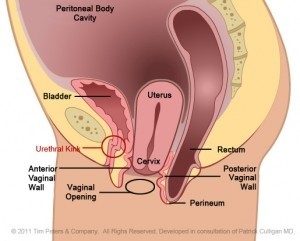Nutrition plays such an important role in our pregnancies and post-partum periods. Breastfeeding requires time…
Prolapse: Pelvic Floor Series 3
The muscles in the pelvic floor are a functional group of many muscles that are the foundation of most of what we do as humans. They work to provide stability in the pelvis, spine and hips. They coordinate with the diaphragm to control intra-abdominal pressure. They are implemental in urination and bowel movements, as well as sexual function. When these muscles are too weak or too tight they don’t function well, and this can cause problems in our daily life. From peeing and pooping, to exercise, to sitting, to sex – when the pelvic floor is not 100%, neither is our daily life. In this blog series we will be touching on several problems that can arise when we have pelvic floor dysfunction.
What is Prolapse?
Lets discus prolapse. Prolapse is a result of weakness in the support system of the organs of the pelvis. This can be caused by pregnancy and childbirth, heavy lifting, chronic coughing or straining caused by chronic constipation. You can have three different types of prolapse, and medically they are called cystocele (bladder), rectocele (rectum) and uterine prolapse. See pictures below for a visual of what each of these look like.
Symptoms
Some symptom that you might experience if you have prolapse are:
- Heaviness in the lower abdomen/pelvis or vagina
- Feeling like something is falling out of your vagina
- Trouble emptying your bladder
- Trouble emptying your bowels
Prolapse is very common immediately following childbirth (and can often linger while you are nursing) until hormones begin to return to pre-pregnancy levels. It is also common as we age, again with the hormonal changes of menopause. The good news is, healthy function of the pelvic floor and surrounding muscles of the abdomen, spine and diaphragm can be restored. Again, the best line of treatment is under the guidance of a specialist in pelvic health. A specialist can assess you individually and determine the best approach at restoring healthy balance in your pelvis.
Methods to Alleviate Symptoms of Prolapse
Some simple methods you can utilize in order to attempt alleviating symptoms are:
- Lie on your back, with your pelvis elevated up on a yoga block or firm pillow to allow organs to slide back into position. Here, perform pelvic floor exercises, tightening these muscles as if you are pulling your tailbone toward your pubic bone. Do sets of 10, up to 8 sets a day.
- Also perform diaphragmatic breathing in this position.
- Avoid heavy lifting, high level exercise like cross fit, HIIT, running, jumping, barre. All of these can create too much pressure in the abdominal and pelvic cavities, worsening prolapse
- Establish healthy bowel and bladder habits
Who Can Help You with Your Prolapse?
Prolapse can respond well to an appropriate exercise program, especially mild to moderate grades of prolapse. Severe prolapse is often managed with a pessary (a conservative alternative to surgery) or surgery. The specialists at Foundational Concepts are trained in assessment of prolapse to help you determine if you will respond to an exercise-based approach, or if you need a surgical consult.
There are many issues that can arise from poor function in the pelvic floor and this blog series is here to address several of these and bring you more information about each one. If you find that these blog topics hit home and you are having some or many of these symptoms, you should consider a free consultation with one of our specialists to determine if treatment is right for you. Click this link to schedule a consultation now (https://www.foundationalconcepts.com/pelvic-pain-therapy/contact/ )






